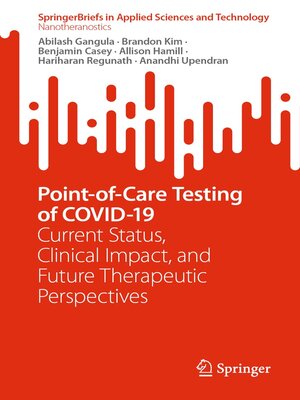Point-of-Care Testing of COVID-19
ebook ∣ Current Status, Clinical Impact, and Future Therapeutic Perspectives · SpringerBriefs in Applied Sciences and Technology
By Abilash Gangula

Sign up to save your library
With an OverDrive account, you can save your favorite libraries for at-a-glance information about availability. Find out more about OverDrive accounts.
Find this title in Libby, the library reading app by OverDrive.



Search for a digital library with this title
Title found at these libraries:
| Library Name | Distance |
|---|---|
| Loading... |
This book highlights the role of point-of-care (POC) testing in the effective management of the coronavirus disease 2019 (COVID-19) pandemic with an in-depth focus on the recent developments in the field, existing gaps, and future directions. POC tests are of utmost importance as they facilitate rapid and decentralized testing without much instrumentation and technical expertise. The book describes the current status of POC COVID-19 testing in three broad categories: Molecular, antigen, and antibody. The advantages, limitations, and adaption of each of the POC tests are reviewed while highlighting their clinical impact in real-world settings. The role of POC testing for COVID-19 screening, diagnosis, and surveillance has been emphasized. The subtle difference between POC and at-home tests is discussed while elaborating on the necessity for the latter for enhancing clinical impacts. A spotlight on the influence of variants on the performance of POC-COVID-19 tests is provided. The consideration of clinical implications of POC testing in hospitals with regards to improving therapeutic options, patient flow, enhancing the infection control measures, and early recruitment of patients into clinical trials is explained. Finally, the future perspectives that will aid the research community in the development of POC tests for COVID-19 or any infectious disease, in general, are presented. Overall, we believe this book can benefit the research community as it (i) presents a comprehensive understanding of current COVID-19 POC testing methods (ii) highlights features required to transform the current tests developed during the past year as POC diagnostics, and (iii) provides insights to address the unmet challenges in the field.






